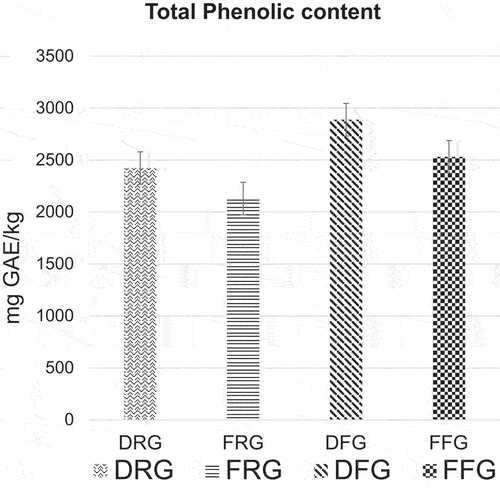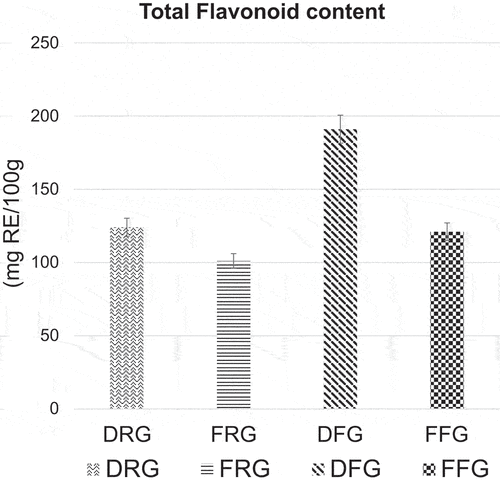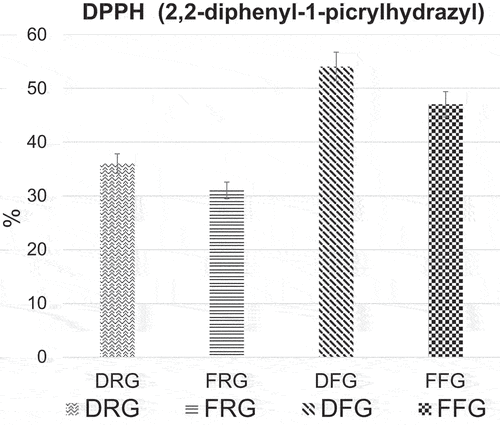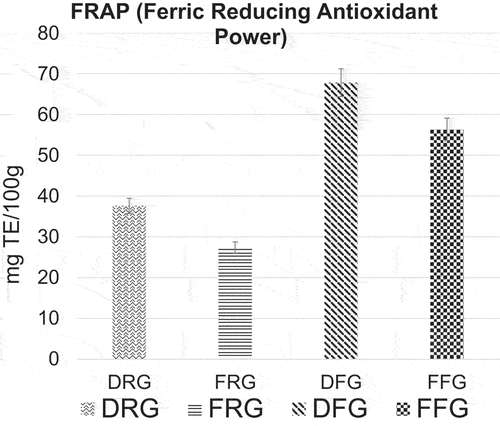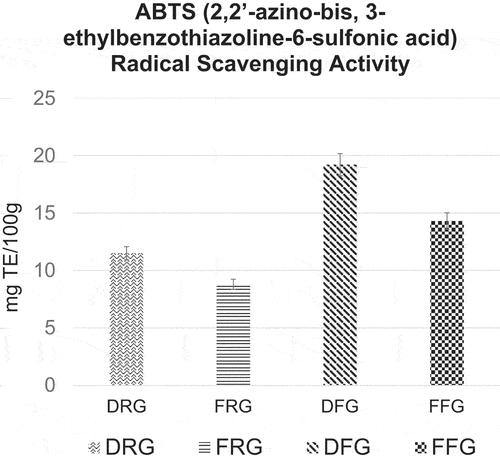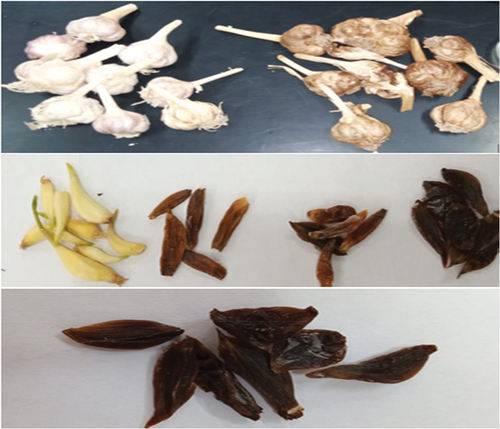ABSTRACT
The core objective of this research work was to determine the nutritional and bioactive profile of raw and fermented (black) garlic. For this purpose, different varieties of garlic i.e., desi and farmi were procured from local market of Faisalabad, Pakistan. In addition, desi raw garlic (DRG) and farmi raw garlic (FRG) were converted into desi fermented (black) garlic (DFG) and farmi fermented garlic (FFG) through fermentation in incubator at 60°C and 70–80% humidity level for 30 days. Moreover, nutritional composition and antioxidant activity of raw and fermented (black) garlic were also elucidated. Results showed that moisture content of garlic was rapidly reduced, whereas crude protein, crude fiber, crude ash, and carbohydrate contents were significantly improved after fermentation. In addition, protein contents of DRG and FRG garlic were 8.57 ± 0.21 and 6.38 ± 0.05 g/100 g whilst 9.5 ± 0.35 and 8.1 ± 0.06 g/100 g, in DFG and FFG, respectively, after fermentation. Additionally, carbohydrate contents were also increased up to 30–40% after fermentation. Mineral contents such as potassium, sulfur, aluminum, iron, sodium, magnesium, zinc, and copper were also increased after fermentation. Furthermore, garlic fermentation significantly reduced pH level. Antioxidant activity showed that total phenolic contents (TPC) of DRG & FRG were 2421.3 & 2128.5 mg GAE/kg while 2886.7, & 2529.8 mg GAE/kg for DFG and FFG, respectively. Total flavonoid contents of DRG and FRG were 124 & 101 mg RE/100 g, whereas DFG and FFG were 191 & 121mgRE/100 g. FRAP, DPPH, and ABTS values were higher in DRG and DFG as compared to FRG and FFG. Conclusively, fermented (black) garlic showed a higher nutritional profile, mineral content, as well as antioxidant activity as compared to raw garlic. C-1: Avoid % for concentration, use more clearly; for examples g/100 g raw materials, g/100 g dry-solids, g/100 g extract, g/100 g oil???) Check all???
Introduction
Functional and nutraceutical foods are becoming very much popular all over the world owing to their health-promoting perspectives, easy accessibility, and low price. The health-promoting potential of such foods is owing to their various bioactive molecules. There are several traditional plants, used as a therapeutic carrier for different physiological threats.[Citation1] Garlic (Allium Sativum L.) plant belongs to the family Amaryllidaceae, which has been used as a food ingredient and medicinal agent for its medicinal properties since ancient times in Asia.[Citation2] It is the most admired ingredient in spice recipes and frequently used as an ingredient in gastronomy in many traditional centuries. It is used in various parts of the world for its antimicrobial activity, insect repellent, and aroma and flavor attributes.[Citation3] It is a glorious natural food item that comprises functional and nutraceutical components that significantly affected human health.[Citation1] Garlic comprises different bioactive components including alliin, allicin, ajoene, diallyl sulfide, diallyl disulfide, diallyl trisulfide, and S-allyl-cysteine.[Citation2,Citation4] Garlic and its bioactive components show antioxidant, anticancer, anti-inflammatory, anti-diabetic, anti-obesity, antibacterial, antifungal, immunomodulatory, cardiovascular protective, hepatoprotective, neuroprotective, and renal protective properties.[Citation5,Citation6] Garlic has been used in alternative medicines to treat high blood pressure, coronary artery disease (hardened arteries), stomach cancer, colon and rectal cancer, as well as to prevent tick bites.
Figure 1. pH values of desi raw garlic (DRG), farmi raw garlic (FRG), desi fermented garlic (DFG) and farmi fermented garlic (FFG).
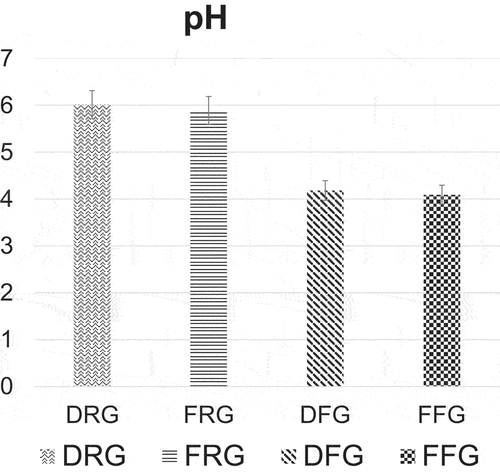
Garlic has a pungent flavor, so garlic intake causes halitosis (bad breath). Food scientists have developed aged garlic preparations to reduce these discomforts. Garlic with different formulations is available in the market. Like, aged garlic is manufactured by soaking sliced raw garlic in 15–20% aqueous ethanol for up to 20-months at room temperature.[Citation7] The extract is then filtered and concentrated under reduced pressure at low temperatures.[Citation8] Fermented garlic (FG) is also a processed garlic product prepared by heat treatment of whole garlic bulbs (Allium sativum L.) at high temperature under high humidity for several days, resulting in fermented cloves with a sweet taste.[Citation9] Fermented garlic is a phenomenon of aged vegetables with multiple biological effects.[Citation10] Fermented garlic has a sweet taste and no pungent odor and that is why can be eaten as fruit just after peeling off the outer coat. Fermented garlic is produced by the process of fermentation of simple fresh garlic (Allium sativum L) under controlled conditions[Citation11,Citation12] In Asia, the concept of aged fermented garlic is improving now and is also known as a functional food. The major challenges in the production of fermented garlic are reduced unpleasant taste and pungent odor. The whole process is heat-dependent. Heating produces aromatic products with gelatin texture and sweet taste.[Citation13] During the aging process, the odorous, harsh, and irritating compounds in fresh raw garlic (FRG) are converted naturally into stable and safe compounds. As a result, BG has a sweet and sour taste and jelly-like texture. This effect together with the high processing temperature explains the longer shelf life of the product. The heating process leads to a Maillard reaction (non-enzymatic browning), creating the typical dark brown color and producing antioxidant compounds.[Citation14]
Black garlic (BG), an aged garlic preparation, is known as a functional food and is popular throughout the world. Compared to fresh garlic, black garlic showed stronger antioxidant and free radical scavenging ability.[Citation15] Many natural substances have the potential to neutralize the harmful reactive oxygen species via an endogenous enzymatic defense system. Many plant-based substances (flavonoids, phenolic acid, and phenolic diterpenes) have significant antioxidant effects.[Citation16] The antioxidant potential of phenolic compounds is due to their redox effect. The phenolic compounds have a key role in absorbing/neutralizing the free radical.[Citation17,Citation18] Keeping in view, the current study was designed to convert raw garlic into fermented (black) garlic to improve its nutritional profile and physicochemical properties as well as bioactivity through fermentation.
Material and Methods
Procurement of Raw Materials
Pakistani garlic varieties desi raw garlic (DRG) and farmi raw garlic (FRG) were procured from local market in Faisalabad, Pakistan. The present research project was carried out in the Department of Food Science at Government College University, Faisalabad. The part of the work was conducted at Ayub Agriculture Research Institute Faisalabad. In the first step, DRG and FRG were converted into desi fermented garlic (DFG) and farmi fermented (black) garlic (FFG) to enhance bioactivity through fermentation and with help of controlled heat treatment with high humidity level followed by its nutritional characterization with special reference to chemical composition, mineral profile, and phenolic content was performed.
Production of fermented (black) garlic
Fermented (black) garlic was produced by using fresh raw garlic in the controlled condition at a temperature (65–85 C) and controlled humidity 70 to 80% in incubator POL-EKO-APARATURA (Model CLN 53 STD) for 20 to 30 days without any additional and treatment fresh garlic change its color white into brown in 15 days and brown turn black into next 7 days with help of browning and Maillard reaction.[Citation19]
Proximate analysis
The chemical analysis of raw garlic (DRG, FRG) and fermented (black) garlic (DFG, FFG) was performed to elucidate the proximate composition, i.e. moisture content, crude protein, crude fiber, crude fat, ash content, and carbohydrate.
Moisture content: Moisture content was estimated by following the procedure described in AACC[Citation20] method No. 44–15A, raw garlic (DRG, FRG) and fermented (black) garlic (DFG, FFG) samples were evaluated for moisture content using a hot air oven at a temperature of 105 ± 5°C.
Ash content: Ash content of DRG, FRG, DFG, and FFG samples was determined by following method No. 08–01 in AACC.[Citation20] Oven-dried samples were taken in pre-weighed crucibles and charred on a burner until incineration in the muffle furnace, temperature 550°C was held until the sample was transformed into grayish-white residue. The residue was cooled at room temperature and then weighed. The percentage of ash content was calculated by the following expression.
Ash (%) = (Ash weight/garlic sample weight) ×100
Crude Protein: The nitrogen content of DRG, FRG, DFG, and FFG samples were determined by using Kjeldahl’s method as defined in method No 46–10 of AACC.[Citation20] The percentage of nitrogen was determined with the following expression:
Nitrogen (%) = (Amount of 0.1 N H2SO4 used ×0.0014 × 250 Wt. of garlic sample) ×100
The percentage of protein was estimated by multiplying % nitrogen with a factor of 5.7
Crude Fat: According to AACC[Citation20] method No. 30–25, the Soxhlet apparatus was used for evaluating crude fat. For this reason, 5 g of each DRG, FRG, DFG, and FFG samples with petroleum ether were extracted at a concentration rate of 2–3 drops/sec at 8 hours. The residue of the extraction flask was dried at 100°C for 30 min after ether distillation. Fat content was estimated by the formula given below.
Crude fat (%) = (Wt. of ether extract/Wt. of garlic sample) ×100
Crude Fiber: The fiber content of DRG, FRG, DFG, and FFG samples were evaluated by removing fat and moisture from the sample that digested with 1.25% H2SO4, then treated with 1.25% NaOH solution. Fiber content was estimated through the Fibertech machine. After charring, the sample was put into a muffle furnace at 550°C till white ash left. Crude fiber value was estimated by AOAC,[Citation21,Citation22] technique no. 32–10. The fiber content was measured according to the formula:
Crude Fiber (%) = (Wt. of reduces left – Wt. of Ash/ Fresh sample wt.) x 100
Carbohydrate: Carbohydrate Content was estimated as per the given expression:
Carbohydrate = 100 – (Moisture % + Crude Fat % + Crude Protein % + Crude Fiber % +Ash %)
Mineral Contents
Garlic samples DRG, FRG, DFG, and FFG were analyzed for its minerals following AOAC method 931.01 (2006). Sample (0.5g) was digested by using HNO3 and perchloric acid at a ratio of 7:3 on hot plate until the solution turned colorless and remained 1–2 mL. Digested sample was diluted up to 100 mL for mineral analysis. Sodium, potassium, and calcium were calculated on Flame Photometer-410 (Sherwood Scientific Ltd., Cambridge); on the other hand, copper, iron, sulfur, and zinc were determined through the Atomic Absorption Spectrophotometer (Varian AA240, Australia).
pH determination
The pH of DRG, FRG, DFG, and FFG was estimated by using a laboratory pH meter (EUTECH INSTRUMENTS pH 700), at room temperature (20°C). Determination was made in three independent replications.
Total phenolic Content
Using the Folin-Ciocalteu reagent, the phenolic contents of DRG, FRG, DFG, and FFG were determined. After 45 min storage at room temperature, the absorption was estimated at 765 nm and the gallic acid was used for the measurement of phenolic content. The findings were expressed as milligrams per kilogram of sample gallic acid equivalent.
Total flavonoid content
According to Jia et al.,[Citation23] the measurement of the total flavonoid contents in the investigated DRG, FRG, DFG, and FFG was spectrophotometrically calculated using a method based on the formation of complex flavonoid-aluminum with maximum absorbability at 430 nm. 1 ml of 2% AlCl3 6H2O was mixed separately with the aqueous dilutions of samples in 1 ml. The absorbance of the reaction mixtures was measured at 430 nm after incubation at room temperature for 15 min.
DPPH Radical Scavenging Assay
DPPH (1, 1-diphenyl-2-picrylhydrazyl) free radical scavenging ability estimation is the most common test to apprehend the antioxidant potential of tested compound. In short, DRG, FRG, DFG, and FFG samples were individually added in DPPH solution (0.12 mM) in test tube (ratio of 4 & 1 ml), respectively, and placed for 30 minutes in a dark place. Afterward, absorbance at 230 nm was recorded by using a UV/Visible Spectrophotometer alongside control and blank according to Mimica-Dukic et al.[Citation24] method.
FRAP (ferric reducing antioxidant power) Assay
FRAP (ferric reducing antioxidant power) test was assessed by the protocol demonstrated by the Benzie and strain[Citation25] with some modification.
ABTS (2, 2’-azino-bis, 3-ethylbenzothiazoline-6-sulfonic acid) Assay
ABTS assays of DRG, FRG, DFG, and FFG were estimated conferring to the method outlined by AOAC (2012).[Citation26] For the preparation of ABTS radicals, % mL freshly prepared ABTS solution (7 mM) was mixed with 5 mL potassium per sulfate solution (2.45 mM) to make 10 mL total volume. The mixture was transferred to opaque bottle and allowed to stand for 16 h in a dark place to achieve a stable oxidized state. The mixture was diluted with ethanol and was adjusted to give 0.7 absorbance at 734 nm. Additionally, 10 µL garlic extract was added 1 mL ABTS solution, mixed thoroughly and subjected to spectrophotometry to measure the absorbance at 734 nm after 30 min stay time. The antioxidant activity using the Trolox standard curve was reported in µmol Trolox /g sample extract.
Statistical Analysis
The data of each parameter was subjected to statistical analysis of variance under fully randomized complete block design or means were further compared by Least Significant Difference (LSD) test to measure the level of significance, and correlation was also implemented. The differences were found to be significant at p < .05 using the SPSS software.
Results and Discussion
Proximate composition
Proximate comparison of raw and fermented (black) garlic is shown in . Nutritional composition g/100 g values of each parameter of DRG, FRG, DFG, and FFG are presented in . Moisture contents of DRG, FRG, DFG, and FFG were 64.3 ± 0.11, 67.5 ± 0.12, 29.5 ± 0.38, and 31.35 ± 0.25 g/100 g, respectively. Current results showed that after fermentation moisture content of raw garlic was reduced up to 40–45%. The moisture content of fermented (black) garlic is a key factor determining its consistency and texture.[Citation27] Water content has a significant impact on food quality since it affects the appearance, hardness, and flavor of food. In black garlic products, water content has a significant impact on the black garlic hardness produced.
Table 1. Chemical analysis of raw and fermented garlic g/100 g (dry solid)
Protein contents of dry-solid DRG, FRG, DFG, and FFG samples were 8.57 ± 0.21, 6.38 ± 0.05, 9.5 ± 0.35, and 8.1 ± 0.06 g/100 g, respectively. Results showed that the protein content of raw garlic has been improved. After fermentation, protein content increases due to enzymatic activity. Therefore, DFG and FFG have higher protein content as compared to DGR and FRG.
Ash contents of dry-solid DRG, FRG, DFG, and FFG were 0.67 ± 0.21, 0.51 ± 0.01, 1.7 ± 0.3, 0.83 ± 0.01 g/100 g, respectively. Ash contents of fermented (black) garlic (DFG and FFG) were higher as compared to raw garlic (DGR and FRG). An increasing trend is shown after fermentation .
Fat content slightly increased after fermentation, dry-solid samples DRG, FRG, DFG, and FFG showed 0.23 ± 0.15, 0.41 ± 0.01 0.4 ± 0.15, and 0.49 ± 0.01 g/100 g fat contents. Fiber contents of DRG, FRG, DFG, and FFG were 2.23 ± 0.01, 2.08 ± 0.02, 2.53 ± 0.02, and 2.49 ± 0.03 g/100 g, respectively.
Carbohydrate contents of DRG, FRG, DFG, and FFG were 23.7 ± 0.3, 22.91 ± 0.03, 46.6 ± 0.55, and 51.28 ± 0.07 g/100 g, respectively. Current comparative study of raw and fermented (black) garlic showed that protein content and carbohydrate content were significantly increased after fermentation. Results showed that desi garlic is superior to farming garlic. Aouadi et al.[Citation28] observed similar results in raw garlic as moisture 64%, protein 7.87%, fat 0.52%, fiber 2.3%, ash 2.46%. Fermentation is a metabolic process in which the complex compounds are converted into simpler compounds.[Citation1] Thus, nutritional composition of garlic has been improved significantly. Various studies have demonstrated that fermentation enhances the bioavailability of nutrients in garlic and makes them easier for the body to digest.[Citation29]
Minerals contents
Mean values for the mineral composition of raw garlic (DRG, FRG) and fermented (black) garlic (DFG and FFG) are presented in . In the current investigation, minerals like potassium (K), sulfur (s) Aluminum, iron (Fe), sodium (Na), magnesium (Mg), zinc (Zn), and copper (Cu) contents in DRG and FRG were 93.4 ± 0.36 & 56.21 ± 0.04, 183.4 ± 0.32 & 110.25 ± 0.02, 0.47 ± 0.25 & 0.87 ± 0.01, 3.11 ± 0.06 & 3.00 ± 0.02, 8.93 ± 0.05 & 4.36 ± 0.58, 15.4 ± 0.31 & 10.62 ± 0.03, 1.53 ± 0.35 & 0.76 ± 0.01, 1.6 ± 0.07 & 0.98 ± 0.01 mg/100 g, respectively. However, the mineral contents of DFG and FFG are as follows; potassium 143.6 ± 0.36 and 101.23 ± 0.03 mg/100 g, sulfur 189.3 ± 0.32 and 135.8 ± 0.03 mg/100 g, Aluminum 25.47 ± 0.21 and 29.85 ± 0.13 mg/100 g, Iron 4.30 ± 0.05 and 3.45 ± 0.02 mg/100 g, sodium 12.91 ± 0.06 and 7.88 ± 0.03 mg/100 g, magnesium 27.43 ± 0.32 and 17.56 ± 0.02 mg/100 g, zinc 1.63 ± 0.08 and 1.23 ± 0.02 mg/100 g, and copper 1.75 ± 0.02 and 0.78 ± 0.01 mg/100 g, respectively. Similarly, Kimura et al.[Citation30] evaluated that mineral content in garlic bulbs and observed potassium, magnesium, zinc, phosphorus, iron, and copper as 10.95, 3.9, 0.44, 9.85, 5.2, and 0.05 mg/100 g, respectively.
Table 2. Mineral contents of raw and fermented garlic
pH
pH values of DRG, FRG, DFG, and FFG were 6.01 ± 0.03, 5.89 ± 0.04, 4.18 ± 0.03, and 4.09 ± 0.01, respectively (). Results showed that pH values of raw garlic were significantly decreased after fermentation. In , DFG and FFG showed lower pH values as compared to DRG and FRG. Because of the low pH caused by the fermentation process, fermented (black) garlic has a comparatively long shelf life.[Citation23] Najman et al.[Citation27] reported that garlic fermentation process decreased pH level by an average of 2.1–2.5. Low pH provides a better ability in eliminating colonies of bacteria or fungus that cause food spoilage.[Citation31]
Total Phenolic Contents (TPC)
Mean values for the TPC of raw and fermented (black) garlic have been presented in . Mean values indicated highest TPC (2886.73 ± 66.6 mg GAE/kg) in DFG followed by DRG 2421.27 ± 24.4 mg GAE/kg. FRG showed minimum phenolic content (2128.52 ± 37.1 mg GAE/kg) and fermented FFG (2529.82 ± 42.2 mg GAE/kg) as compared to DRG and DFG. The results of the current study depicted that various phytochemicals exist in raw and fermented (black) garlic. The color, smell, and flavor of the plant are due to the presence of these phenolic compounds. Furthermore, these phenolic compounds protect plants against insects, fungi, parasites, and pathogens and so become the major part of the plant’s natural defense system. The results of the instant investigation are comparable with the findings of Jang et al.[Citation32] illuminated that the polar fraction of garlic contains an appreciable antioxidant potential. They examined fresh garlic and the aged garlic, i.e. fermented (black) garlic and observed TPC in ethanol extract of garlic as 2.86 mg GAE/g and in fermented (black) garlic as 43.01 mg GAE/g and in aqueous extract as 5.68 and 147.58 mg GAE/g in garlic and fermented garlic correspondingly.
Total Flavonoid Contents
Mean values for the total flavonoid content of raw and fermented (black) garlic are presented in . The mean values of the total flavonoids in DRG exhibited as 124 ± 4.6 and DFG 191 ± 3.8 mg RE/100 g. Results showed that the total flavonoid content in FRG was 101 ± 3.4 mg RE/100 g and FFG was 121 ± 4.1 mg RE/100 g. Flavonoids are phenolic compounds that have antioxidant abilities such as free radical scavengers, regeneration of alpha-tocopherols and metal chelation. The result of the current study is in line with the previous work of Jang et al.[Citation32] investigated total flavonoid content and observed 35.07 and 124.08 µg QE/g in garlic and fermented (black) garlic.
DPPH scavenging activity
Mean values for the DPPH activity of raw and fermented (black) garlic have been presented in . DPPH activity illustrated that the mean values of DRG as 36 ± 0.06% and DFG was 54 ± 0.12%. FRG and FFG showed DPPH values 31 ± 0.05 and 47 ± 0.09%, respectively. DPPH method is used to estimate the free radical hunting activity by utilizing the stable radical. The free radicals are hunted as the spare electron delocalizes over the molecule. The purple color in methanol indicates the delocalization of free electrons turned to pale yellow (Molyneux, 2004). The observations of Jang et al.[Citation32] confirmed the findings of the present investigation regarding DPPH and found 11.22 and 51.16% in ethanolic extract of garlic and fermented garlic and 20.86 and 79.21% in aqueous extract of garlic and fermented garlic.
FRAP (ferric reducing antioxidant power)
Mean values for the FRAP Radical Scavenging Assay of raw and black garlic have been presented in . FRAP values of DRG, FRG, DFG, and FFG were 37.6 ± 0.06, 27.4 ± 0.07, 67.8 ± 0.16, and 56.3 ± 0.09 mg TE/100 g, respectively. Results of the FRAP test showed that the highest FRAP is 67.8 ± 0.16 mg TE/100 g was observed in DFG.
ABTS Radical Scavenging Activity
Mean values for the ABTS Radical Scavenging Assay of raw and fermented (black) garlic have been presented in . The means regarding ABTS of solvent extracts showed that the highest ABTS value was 11.5 and 19.2 mg Trolox/100 g in DRG and DFG, respectively. However, FRG and FFG results showed 8.8 and 14.3 mg Trolox/100 g values, respectively. The current findings are supported by the work of Nassur et al., who[Citation33] observed ABTS in raw garlic and fermented (black) garlic and showed that fermented garlic ABTS increased similarly ().
Conclusion
Garlic has an excellent biochemical composition, but fermentation also increased the nutritional value of raw garlic especially protein and carbohydrates contents. Fermentation improved the bioactive profile of raw garlic. It significantly decreased the pH of raw garlic and enhanced the shelf life of fermented garlic due to its acidic food properties. Pakistani desi raw and fermented (black) garlic has much nutritional and antioxidant activity as compared to farmi raw and fermented garlic (black).
Disclosure statement
No potential conflict of interest was reported by the author(s).
References
- Afzaal, M.; Saeed, F.; Rasheed, R.; Hussain, M.; Aamir, M.; Hussain, S.; Mohamed, A. A.; Alamri, M. S.; Anjum, F. M. Nutritional, Biological, and Therapeutic Properties of Black Garlic: A Critical Review & Anjum. F. M. Int. J. Food Prop. 2021, 24(1), 1387–1402. DOI: 10.1080/10942912.2021.1967386.
- Shang, A.; Cao, S. Y.; Xu, X. Y.; Gan, R. Y.; Tang, G. Y.; Corke, H.; Li, H. B.; Li, H.-B. Bioactive Compounds and Biological Functions of Garlic (Allium Sativum L.). Foods. 2019, 8(7), 246. DOI: 10.3390/foods8070246.
- Satyal, P.; Craft, J. D.; Dosoky, N. S.; Setzer, W. N. The Chemical Compositions of the Volatile Oils of Garlic (Allium Sativum) and Wild Garlic (Allium Vineale). Foods. 2017, 6(8), 63. DOI: 10.3390/foods6080063.
- Padiya, R.; K Banerjee, S. Garlic as an Anti-diabetic Agent: Recent Progress and Patent Reviews. Recent Pat. Food, Nutr. Agric. 2013, 5(2), 105–127. DOI: 10.2174/18761429113059990002.
- Tavares, L.; Santos, L.; Noreña, C. P. Z. Bioactive Compounds of Garlic: A Comprehensive Review of Encapsulation Technologies, Characterization of the Encapsulated Garlic Compounds and Their Industrial Applicability. Trends Food Sci. Technol. 2021, 114, 232–244. DOI: 10.1016/j.tifs.2021.05.019.
- Petropoulos, S.; Fernandes, Â.; Barros, L.; Ciric, A.; Sokovic, M.; Ferreira, I. C. Antimicrobial and Antioxidant Properties of Various Greek Garlic Genotypes. Food Chem. 2018, 245, 7–12. DOI: 10.1016/j.foodchem.2017.10.078.
- Kim, H. K. The Inhibition Effects of Hypercholesterolemia and Platelet in Fermented and Non-Fermented Preparation of Garlic. Ijibc. 2019, 11(4), 1–10.
- Elosta, A.; Slevin, M.; Rahman, K.; Ahmed, N. Aged Garlic Has More Potent Antiglycation and Antioxidant Properties Compared to Fresh Garlic Extract in Vitro. Sci. Rep. 2017, 7(1), 39613. DOI: 10.1038/srep39613.
- Ríos-Ríos, K. L.; Montilla, A.; Olano, A.; Villamiel, M. Physicochemical Changes and Sensorial Properties during Black Garlic Elaboration: A Review. Trends Food Sci. Technol. 2019, 88, 459–467. DOI: 10.1016/j.tifs.2019.04.016.
- Van Wyk, B. E.; Wink, M. Medicinal Plants of the World. 2018.
- Al-Shehri, S. A. Efficacy of Black Garlic Extract on Anti-tumor and Anti-oxidant Activity Enhancement in Rats. Clin Nutr. Open Sci 2021, 36, 126–139. DOI: 10.1016/j.nutos.2021.03.005.
- Yuan, H.; Sun, L.; Chen, M.; Wang, J. The Comparison of the Contents of Sugar, Amadori, and Heyns Compounds in Fresh and Black Garlic. J. Food Sci. 2016, 81(7), C1662–C1668. DOI: 10.1111/1750-3841.13365.
- Jeong, Y. Y.; Ryu, J. H.; Shin, J. H.; Kang, M. J.; Kang, J. R.; Han, J.; Kang, D. Comparison of Anti-oxidant and Anti-inflammatory Effects between Fresh and Aged Black Garlic Extracts. Molecules. 2016, 21(4), 430.
- Kang, O. J. Physicochemical Characteristics of Black Garlic after Different Thermal Processing Steps. Prev. Nutr. Food Sci. 2016, 21(4), 348. DOI: 10.3746/pnf.2016.21.4.348.
- Kim, J. H.; Nam, S. H.; Rico, C. W.; Kang, M. Y. A Comparative Study on the Antioxidative and Anti‐allergic Activities of Fresh and Aged Black Garlic Extracts. Int. J. Food Sci. 2012, 47(6), 1176–1182.
- Shahidi, F.; Janitha, P. K.; Wanasundara, P. D. Phenolic Antioxidants. Crit. Rev. Food Sci. Nutr. 1992, 32(1), 67–103.
- Bekono, B. D.; Ntie-Kang, F.; Onguéné, P. A.; Lifongo, L. L.; Sippl, W.; Fester, K.; Owono, L. C. The Potential of Anti-malarial Compounds Derived from African Medicinal Plants: A Review of Pharmacological Evaluations from 2013 to 2019. Malar. J. 2020, 19(1), 1–35. DOI: 10.1186/s12936-020-03231-7.
- Gezici, S.; Şekeroğlu, N. Current Perspectives in the Application of Medicinal Plants against Cancer: Novel Therapeutic Agents. Anti-Cancer Agents Med. Chem. (Formerly Current Medicinal Chemistry-Anti-Cancer Agents). 2019, 19(1), 101–111.
- Sun, Y. E.; Wang, W. Changes in Nutritional and Bio-functional Compounds and Antioxidant Capacity during Black Garlic Processing. J. Food Sci. Technol. 2018, 55(2), 479–488. DOI: 10.1007/s13197-017-2956-2.
- AACC. Approved Methods of American Association of Cereal Chemists (10th Ed.). American Association Cereal Chemists. 2000, Inc., St. Paul, MN.
- AOAC. Official Methods of Analysis of AOAC International, 17th ed.; AOAC International: Maryland, USA, 2002.
- AOAC. Official Methods of Analysis, 18th Ed. [ Revised] Association of Official Analytical Chemists. 2006, Washington, DC.
- Jia, Z.; Wang, Z.; Xu, C.; Liang, J.; Wei, B.; Wu, D.; Zhu, S. Study on Poly (Methyl Methacrylate)/carbon Nanotube Composites. Mater. Sci. Eng. A. 1999, 271(1–2), 395–400. DOI: 10.1016/S0921-5093(99)00263-4.
- Mimica-Dukic, N.; Bozin, B.; Sokovic, M.; Simin, N. Antimicrobial and Antioxidant Activities of Melissa Officinalis L. (Lamiaceae) Essential Oil. J. Agric. Food Chem. 2004, 52(9), 2485–2489. DOI: 10.1021/jf030698a.
- Benzie, I. F.; Strain, J. J. The Ferric Reducing Ability of Plasma (FRAP) as a Measure of “Antioxidant Power”: The FRAP Assay. Anal. Biochem. 1996, 239(1), 70–76. DOI: 10.1006/abio.1996.0292.
- AOAC International. Official Methods of Analysis of AOAC International, 19th ed.; AOAC: Gaithersburg, MD, 2012.
- Najman, K.; Sadowska, A.; Hallmann, E. Influence of Thermal Processing on the Bioactive, Antioxidant, and Physicochemical Properties of Conventional and Organic Agriculture Black Garlic (Allium Sativum L.). Appl. Sci. 2020, 10(23), 8638. DOI: 10.3390/app10238638.
- Aouadi, R.; Aouidet, A.; Elkadhi, A.; Rayana, M. C. B.; Jaafoura, H.; Tritar, B.; Nagati, K. Effect of Fresh Garlic (Allium Sativum) on Lipid Metabolism in Male Rats. Nutr. Res. 2000, 20(2), 273–280. DOI: 10.1016/S0271-5317(99)00159-1.
- Correa, M. J.; Burbano Moreano, J. J.; Guardianelli, L. M.; Weisstaub, A. R.; Zuleta, A.; Salinas, M. V. Garlic: A Natural Bread Improver for Wheat Bread with A High Level of Resistant Starch. J. Food Process. Preserv. 2021, 45, e15519.
- Kimura, S.; Tung, Y. C.; Pan, M. H.; Su, N. W.; Lai, Y. J.; Cheng, K. C. Black Garlic: A Critical Review of Its Production, Bioactivity, and Application. J. Food Drug Anal. 2017, 25(1), 62–70. DOI: 10.1016/j.jfda.2016.11.003.
- Rahman, M. S.;. Handbook of Food Preservation, 2nd ed.; CRC Press: New York, NY, USA, 2007.
- Jang, E. K.; Seo, J. H.; Lee, S. P. Physiological Activity and Antioxidative Effects of Aged Black Garlic (Allium Sativum L.) Extract. Korean Soc. Food Sci. Nutr. 2008, 40, 443–448.
- Nassur, R. C. M. R.; Vilas Boas, E. D. B.; Resende, F. V. Black Garlic: Transformation Effects, Characterization and Consumer Purchase Intention. Comunicata Scientiae. 2017, 8(3), 444–451. .

